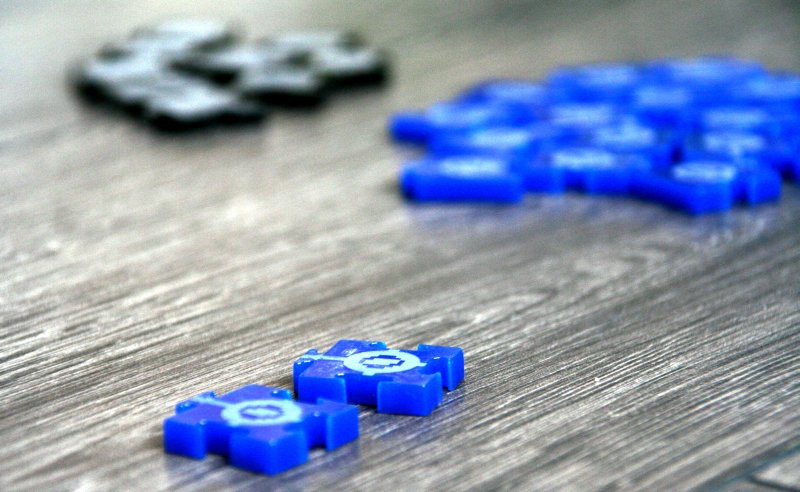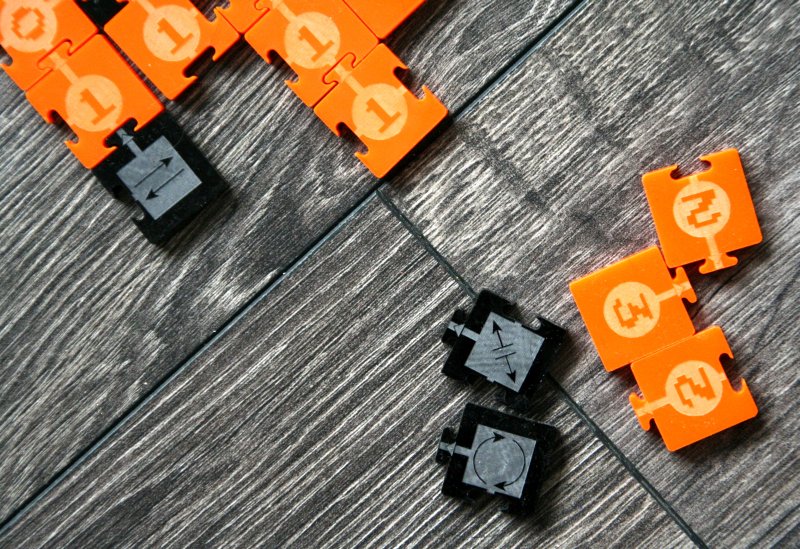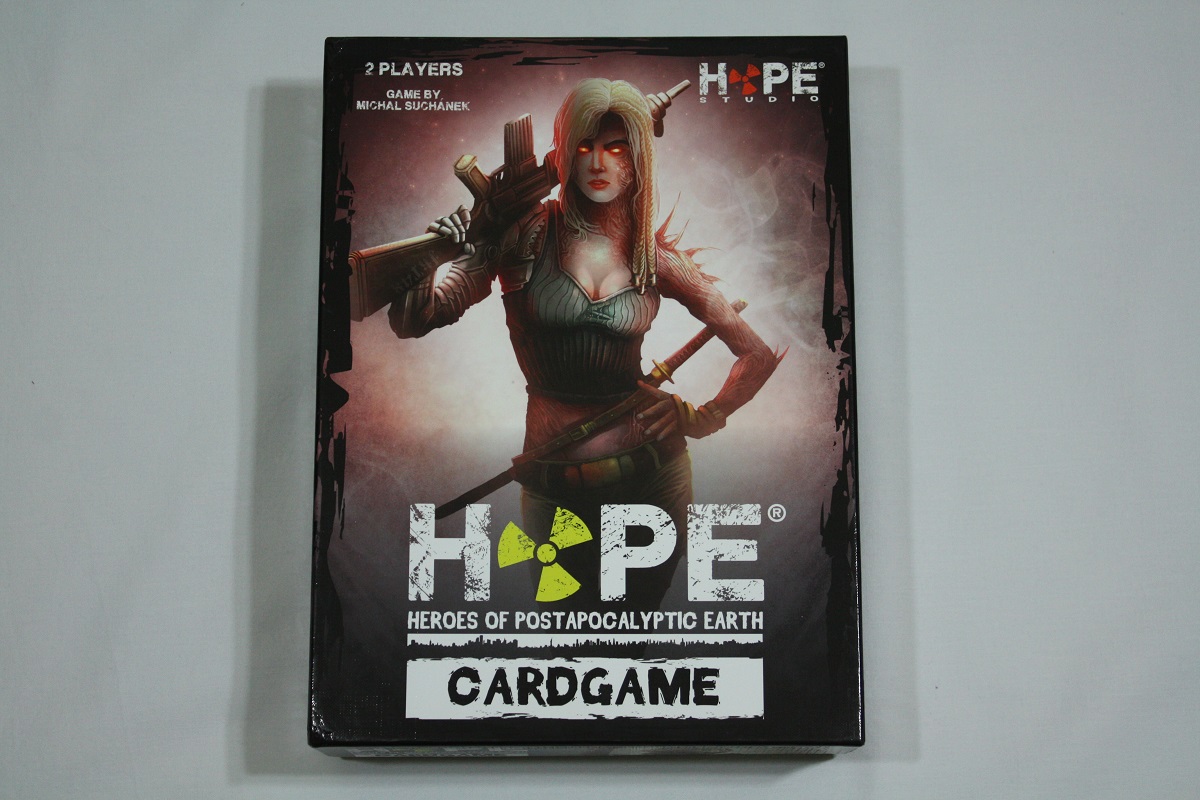Electricity flows in one direction only. All you need to do is watch it, listen to its crackle and wait, where flicker emerges. You always have one certainty – there will be a finish to its journey. Someplace, where you can save or consume electricity. Electrical circuits are predictable.
And yet their building is not as easy as it might seem. Let’s try it in board game Breaker Blocks, which flies under the radar of interest of majority of players. Its author is Jacob Vander Ende and graphic designer is called Lex Piccione. Their joint work was published under flag of small Spriteborne company, a print on demand (more of a make on demand) firm. All from a single office, where author carves pieces with laser and burns characters needed to play on them.
Even the bag, in which you get the game, is finish by hand. However, it can also be seen on its label, which is slowly fading away after few months. In its bowels, we find a pile of colorful, plastic and shiny stones. Blue and orange are colors of players, who get their stones numbered from zero up to a maximum of three. Each piece has its holes and feet to connect to each other as some form of puzzle.
And then there are also black stones. They have either Roman numerals I, II and III on them, with no legs or different symbols denoting special skills. Our list can calmly finish with these stones. Rules were not in our bag, but we could download them from official Spriteborne website, http://www.spriteborne.com/products/breakerblocks
Which stones do we need to begin with? All of them. We divide them into three piles, with white pictures up and let the two adversaries (yes, game is for two!) look well at what lies ahead. Center of the table is then occupied by trio of target devices to be powered. This is one tile with three circuits designated by Roman numerals. Both opponents then get their hands on first two stones of their chosen colors – those with value zero.
Followed by a match, in which opponents will rotate and use two action points to choose from total of three actions. First is getting new stone (newly acquire). Choice is always not only from player’s own color, but also from all action black pieces.
Stones should then be connected and create energy supplies for the starting three, creating a chain with more and more power coming in. Players start by connecting to one of the three starting circuits and from that moment on, this line of stones can only be continued by themselves. Circuits with roman numbers have two or three positions, which can be connected to, so both opponents have a chance to wrestle for each target. It will be important for the final sum – energy, that player feeds to each individual circuit. On the other hand, remaining stones have different number of connection points.
But before situation comes to evaluate, third action can often occur. Stones that are at the end of one circuit and no other tile is attached to them can be moved to any other location of the whole construction .
Once the board shows two verification tiles, game immediately ends and it’s time to determine, who is in control of most devices (usually two out of three, if there is not tie). Players add the strength of their stones coming to each number and compare energy with their adversary. They do it in separately for all three districts and the one, who controls most of them, is the winner.
Breaker Blocks is clever abstract game, in which number of important factors plays important role. The main advantage is diversity of stones. The stronger the building block is, the less openings for the connection is has. This is great, because the most valuable three-point stone has only one leg to connect it and no further extension holes in it. Players must think carefully about using it.
But this is not the end. Playing is important not only regarding each stone, because players have to retain their positions and seeks to promote the right battlefield. Much better chance to influence and change their chance is opportunity to move stones, which is crucial action for both players.
Equally important are special stones, that allow you to remove stones from the board or get more stones into your hand. It is also the only fundamental way to manipulate possibilities of your opponent. Otherwise, everything depends purely on how players can use their available options and no luck is involved.
Games are pleasantly fast, because only two opponents constantly alternate. But they still always have two actions and may indeed prove something to make a change. Everyone is responsible for development of his game side from the very beginning.
In the game, it’s hard to detect any clear strategy. Each step can be corrected by another opponent tactics, so everything depends on the right combinations from the start to the end. One stroke can lead to victory, but so can also be start of destruction. Everything can be averted and changed.
Design is very good. Handmade pieces are high quality, they fit together well and hold in place. Symbols are legible and bag is ideal for storing, which also allows for easy carrying.
Blocks Breaker deserves place among leading abstract logic games, that is moved up not only by luxurious hand treatment, but above all really well thought out gameplay. Players are facing heavy choices, belonging to any such thinking game. Breaker Blocks is doing everything well and this is why it is easily recommended to everyone.
<br><br>
| Informace o hře ze serveru BoardGameGeek (odkazy směřují tam) | |
| Autor | Jacob Vander Ende |
| Ilustrace | Jacob Vander Ende |
| Vydavatel | Spriteborne |
| Rok vydání | 2015 |
| Počet hráčů | 2 - 2 |
| Herní doba | 30 |
| Minimální věk | 0 and up |
| Kategorie | Abstract Strategy, Number |
| Mechanismy | Area Majority / Influence, Modular Board, Network and Route Building, Tile Placement |
| Rodina | Crowdfunding: Kickstarter, Players: Two-Player Only Games |
Více o hře.


+ great processing
+ portable packaging
+ special stones
+ fast game time
+ smart majority fight
- not easily available for buying and testing
























